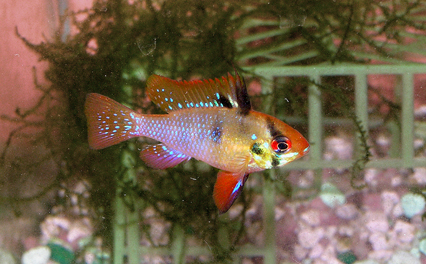The Ram cichlid or Microgeophagus ramirezi belongs to the family Cichlidae more commonly referred to as cichlids. They are endemic to Orinoco River basin in Venezuela and Columbia. The aquarium industry markets rams under several trade names including; Ram, Blue ram, German blue ram, Asian ram, butterfly cichlid, dwarf butterfly and Ramirez's dwarf cichlid. The Ramirez's dwarf cichlid is a hybrid originally bred by fish enthusiast Manuel Ramirez.
 |
| Ram Cichlid - Photo by boscosami (cc) |
Ram Cichlids thrive in slightly acidic water. A pH of 6.8 with a water temperature range between 72- 78°F is the ideal environment for keeping rams. Under premium conditions you can expect your ram cichlids to live for up to four years.
Rams are omnivorous. They can survive just fine on common variety tropical fish flakes. But supplementing their diet with live food such as brine shrimp, frozen or freeze dried food will help insure their vigor.
Distinguishing males from females isn't difficult. This species is sexually dimorphic, males being larger than females. Males typically possess longer spines on the front of their dorsal fin. Females have rounder abdomens than males. This trait is quite apparent when they are carrying eggs.
Breeding Ram Cichlids
Both the male and the female typically become more colorful when its time to breed. The abdomen of a females' body turns reddish or pinkish when she enters into her spawning cycle. A slightly acid water and warmer water temperatures will help induce spawning.
You will want to place the pair in a breeding tank. Males can become territorial when they enter their breeding cycle.
You will know your rams are about to spawn when the expectant parents begin to clean a flat surface to deposit their eggs on. Cichlids rarely deposit their eggs on barren substrate when a more suitable nursery is available.
The latest trend among Saltwater Tank enthusiasts is raising pet jellyfish. Jellyfish need specially designed Jellyfish Fish Tank Aquariums. Jellyfish tanks are easier to maintain than traditional saltwater setups. Moon Jellies are the most popular jellyfish among home aquarists both for their exotic beauty and their ease of care. They have become so popular that two US based websites are now tank raising them to meet the growing demand. Pet Moon Jellyfish look absolutely incredible under a fading LED lighting system.
Article Source: EzineArticles
|

No comments:
Post a Comment